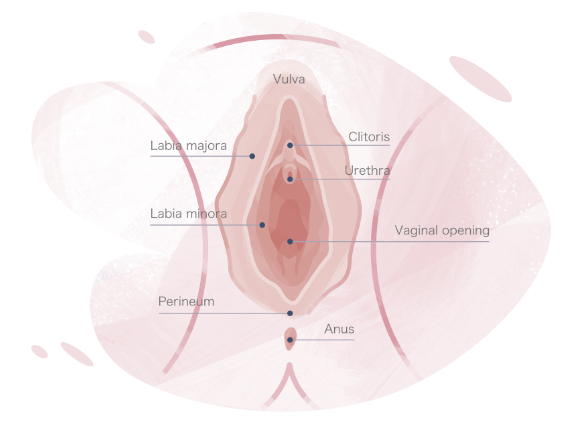
A healthy vagina is made up of “healthy” and “unhealthy” microbes that live in harmony.
A healthy vagina may look different for everyone! Vaginas differ in:
Get to know your vagina
You can get comfortable with your vagina by doing a self-exam with a handheld mirror. Start with the outer and inner lips of the vagina, the fleshy folds of skin that surround the vaginal opening. These are called the labia or the vulva and can vary in , ranging from pink to dark brown to black. Check for any:
- Lumps
- Bumps
- Sores
- Rashes
The more often you do a self-exam, the better you will know what is normal for you.
1 in 4 women do not know where their vagina is.
The clitoris is a spongy tissue sitting at the top of the vulva (toward the front of your body), where the inner labia meet. It swells when you are aroused.
Within the inner labia, there are two holes:
To the front, right below the clitoris, is a small opening called the urethra. This is where you pee from.
Behind the urethra is the larger vaginal opening. In most people, the vagina is the connection between the uterus and the outside. This is where menstrual blood exits your body, where sexual intercourse can happen, and where babies are born.
The anal opening is further to the back, between your buttocks. It is the last part of the rectum, where stool leaves the body.
What does a healthy vagina smell like?
All healthy vaginas have a smell. Each vagina’s odor is unique and varies depending on what phase of the menstrual cycle you’re in color.
It can also be affected by your hygiene practices. Vaginal odor can smell different when there is an underlying vaginal infection, called vaginitis.
In most cases, the vaginal odor will smell bad during an infection. The smell can sometimes be described as “fishy” or “rotten.” Knowing how your vagina typically smells will help you recognize when things are not right.
Some vaginal discharge is normal. Healthy vaginal discharge is usually clear or white and odorless Depending on the phase of the menstrual cycle, vaginal discharge can be thin and thick.
A change in the normal pattern of the color and smell of your discharge could be a sign of infection or inflammation in the vagina.
Causes of unhealthy Vaginal include:
- Improper hygiene
- Exposure to an irritant or allergen
- Increased stress
- Illness
- Unsafe sex
When this happens, several symptoms occur that may suggest that your vagina is unhealthy or that there is an underlying vaginal infection. These symptoms include:
- Itching
- Burning
- Abnormal vaginal discharge
- Pain
- Odor
- Lumps/bumps
- Rashes
Recommendations for good vaginal health
Don’t scratch it when it itches.
Don’t douche.
Wear white, 100% cotton underwear and loose clothing.Avoid nylon and rayon.
Avoid panty liners and thongs.
Use unscented tampons for menstrual bleeding. Don’t leave tampons in for longer than 8 hours.
Use mild, unscented soap for showering and bathing.
Avoid detergents, dryer sheets, and fabric softeners with fragrance.
Avoid feminine sprays/deodorants, bubble baths, bath oils, talc, and powder.
How to clean your vagina
Cleaning your genitals should be part of your daily routine. But cleaning the inside of your vagina is not needed. Using a little amount of soap and warm water, clean the outer and inner parts of the vulva. Use your fingertips instead of a washcloth, to avoid irritating the skin. Pat your vulva dry with a soft towel once you’re clean.
To clean your vaginal, you should also wipe from front to back after using the toilet. And as always, practice safe sex by using condoms to avoid contracting or spreading infections.
